Overview
The article provides a comprehensive guide on how to change data types in Power BI, emphasizing the importance of correctly categorizing information for effective data management and analysis. It outlines various methods, including using the Query Editor, DAX functions, and the Ribbon’s ‘Data Type’ option, while also addressing common challenges and best practices to enhance reporting accuracy and operational efficiency.
Introduction
In the dynamic realm of Business Intelligence, mastering data types in Power BI is not just a technical necessity; it is a strategic advantage that can propel organizations toward operational excellence. Understanding the nuances of data types—whether Text, Number, Date, or Boolean—plays a critical role in ensuring accurate data interpretation and effective reporting.
As organizations increasingly rely on data-driven insights for decision-making, the ability to manage these types effectively becomes paramount. This article delves into the essential methods for changing data types, highlights common challenges faced during this process, and outlines the myriad benefits of proper data type management.
By embracing best practices and leveraging advanced tools, users can transform their data management processes, enhancing both the quality of insights and the overall efficiency of their Power BI solutions.
Understanding Data Types in Power BI
In a business intelligence tool, specifying information types is essential to efficient information management, particularly in a setting increasingly dependent on Business Intelligence (BI) for informed decision-making. The primary information types—Text, Number, Date, and Boolean—have distinct characteristics that significantly influence how Power BI changes data type and interprets and processes information. For instance, a column designated as Text restricts mathematical operations, while a Number column is designed for aggregation and statistical analysis.
This distinction is essential not only for crafting precise reports and impactful visualizations but also for overcoming common challenges such as time-consuming report creation and inconsistencies. As Harris Amjad accurately notes,
Descriptive statistics also aid us in comprehending the environment surrounding us,
highlighting that the appropriate categories enhance better insights. Incorrectly assigning classifications can result in mistakes in computations and misrepresentations in visual displays, highlighting the significance of precise categorization when you need to use Power BI to change data type.
The real-world consequences of mismanagement of information classifications are illustrated in a worked example of view and viewer metrics, showcasing how metrics derived from user interactions with reports clarify the essential nature of information categories in evaluating report performance. Moreover, utilizing RPA tools such as EMMA RPA and Automate can simplify workflows and improve efficiency, making it even more essential to handle information categories effectively. For example, the standard deviation for profit and revenue columns can be calculated by creating separate measures and selecting ‘Standard Deviation’ from the ‘Statistics’ options, providing further context on the importance of precise information.
By mastering information categories and utilizing RPA solutions, users can significantly enhance report precision and the overall effectiveness of their BI solutions, transforming information into a powerful asset for growth and innovation.
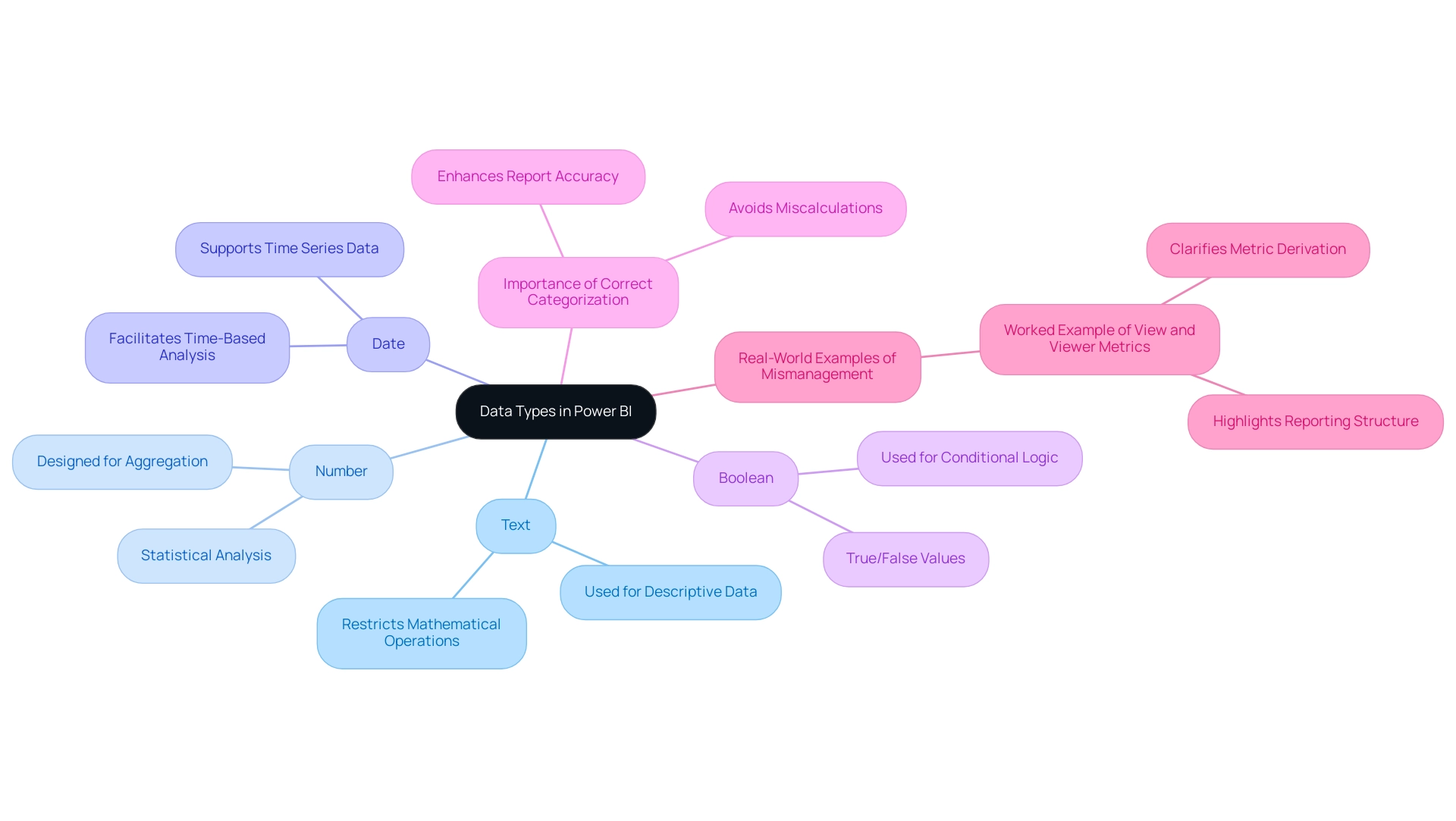
Methods for Changing Data Types in Power BI
-
Using the Query Editor: Access the Query Editor by clicking on ‘Transform Data’. Select the column you wish to modify, right-click on it, and choose the ‘powerbi change data type’ option from the context menu. This intuitive approach enables you to effortlessly choose your preferred information category, ensuring your information aligns with your analytical requirements. Power BI supports various information forms, including text, numbers, dates, and geographical information, making it versatile for different analytical scenarios and essential for generating actionable insights that drive growth.
-
Utilizing the Information Model: Navigate to the Model view and select the column in question. In the Properties pane, you can easily modify the information category from a dropdown menu. This approach is especially advantageous for users who favor handling information categories at the model level for uniformity across reports. Establishing uniform information management practices can assist in alleviating typical issues like inconsistencies in reporting.
-
Utilizing DAX Functions: For individuals working with calculated columns, applying DAX functions such as
FORMAToffers a strong method to clearly specify the information category when creating new columns. This method is particularly beneficial when you need to create new categories based on current information, allowing for greater versatility in your information management. Such adaptability is crucial in a data-rich environment where timely insights are key to operational efficiency. -
Navigating the Ribbon’s ‘Data Type’ Option: In the Data view, select your target column and head to the ‘Column tools’ tab on the ribbon. Here, you can choose the suitable type from the ‘Type’ dropdown. This option simplifies the process for individuals who favor a visual method for information management in Power BI, particularly when they need to change data types, thereby improving engagement and the overall effectiveness of BI.
-
Integrating RPA Solutions: To further improve information management processes, consider implementing Robotic Process Automation (RPA) solutions. RPA can automate repetitive tasks involved in preparation and reporting, significantly reducing the time spent on manual entry and allowing teams to focus on analysis and insight generation. This integration is essential for addressing challenges like time-consuming report creation and ensuring consistency across your BI dashboards.
Each of these methods provides unique benefits suited to various user preferences and contexts. As you explore these options, consider the latest updates in Power BI for 2024, which enhance the Power Query Editor’s functionality, making the process even more efficient. Furthermore, utilizing unique formats, such as Image URL and Web URL, can enhance the interactivity and visual attractiveness of your reports, offering instant access to external resources.
For example, utilizing these unique formats enables individuals to showcase images and generate clickable hyperlinks in reports, improving engagement. A recent user, Nikola, noted,
And, the entire model size is now ca. 220 MB instead of 635 MB,
emphasizing the significance of effective information management in enhancing performance.
Furthermore, it’s important to mention that Fixed Decimal Number formats permit four digits to the right of the decimal separator, accommodating up to 19 significant figures, which is essential for accurate information management.
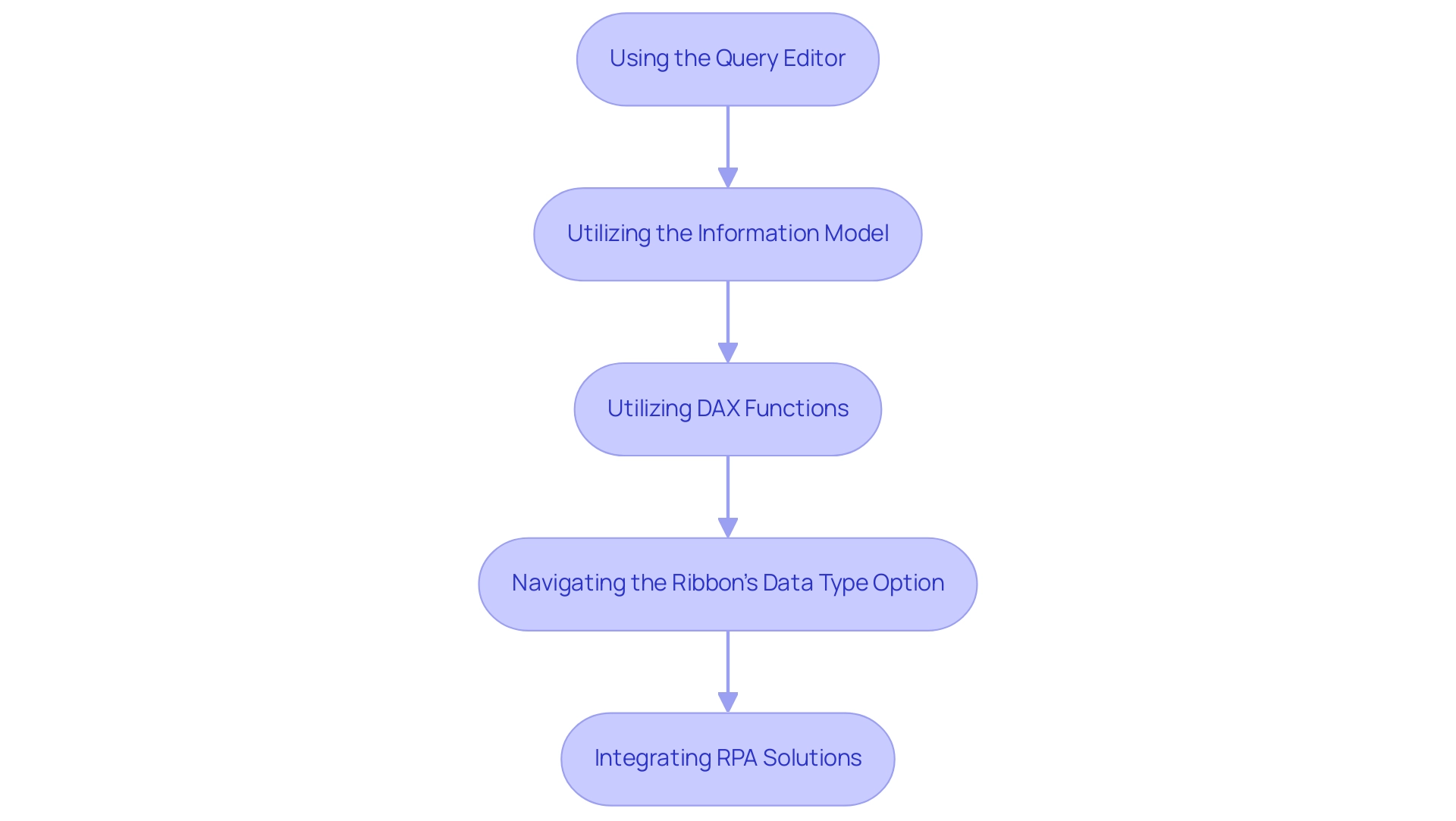
Common Challenges When Changing Data Types
Changing data types in Power BI can present several notable challenges that users should be aware of, especially in the context of leveraging Business Intelligence and RPA for operational efficiency:
-
Information Loss: Changing a column from a more specific format, such as Date, to a broader format like Text can lead to considerable information loss or misinterpretation of values. This misstep can lead to inaccurate reporting and analysis, hindering your ability to draw meaningful insights that drive business growth and may place your organization at a competitive disadvantage.
-
Incompatibility Issues: Actions conducted on incompatible formats frequently result in mistakes. For instance, attempting to sum a column formatted as Text will result in a failure, disrupting workflow, productivity, and the overall decision-making process. Tools like EMMA RPA can assist in automating validation processes, decreasing the chances of such errors.
-
Performance Impact: Frequent alterations to formats can negatively influence report performance, especially in large collections. It is recommended to finalize information categories early in the preparation process to maintain optimal performance and ensure that your dashboards provide timely insights. Automate can assist in streamlining these processes, enhancing operational efficiency.
-
Information Format Conflicts: In instances where an information source contains varied formats within a single column, BI may default to a format that does not align with expectations, leading to confusion and potential errors that could hinder effective information utilization.
To effectively mitigate these challenges, it is crucial for users to thoroughly review their information both before and after executing a powerbi change data type, ensuring consistency throughout their datasets. This vigilance can significantly reduce the risk of encountering these common issues, allowing for a smoother information management experience in BI. As Stephanie William aptly inquired, “I would like to know if it’s possible to convert profile information into the Power BI dash?”
Numerous individuals are seeking to utilize information effectively, and grasping these challenges is an essential step toward accomplishing that objective. Notably, with 7,019 users currently online, this topic resonates with a broad audience. Furthermore, the case study on the Blank Format in DAX demonstrates how the Blank format signifies SQL nulls and can be generated using the BLANK function, emphasizing effective management of null values within BI models and showcasing practical solutions to the format challenges discussed.
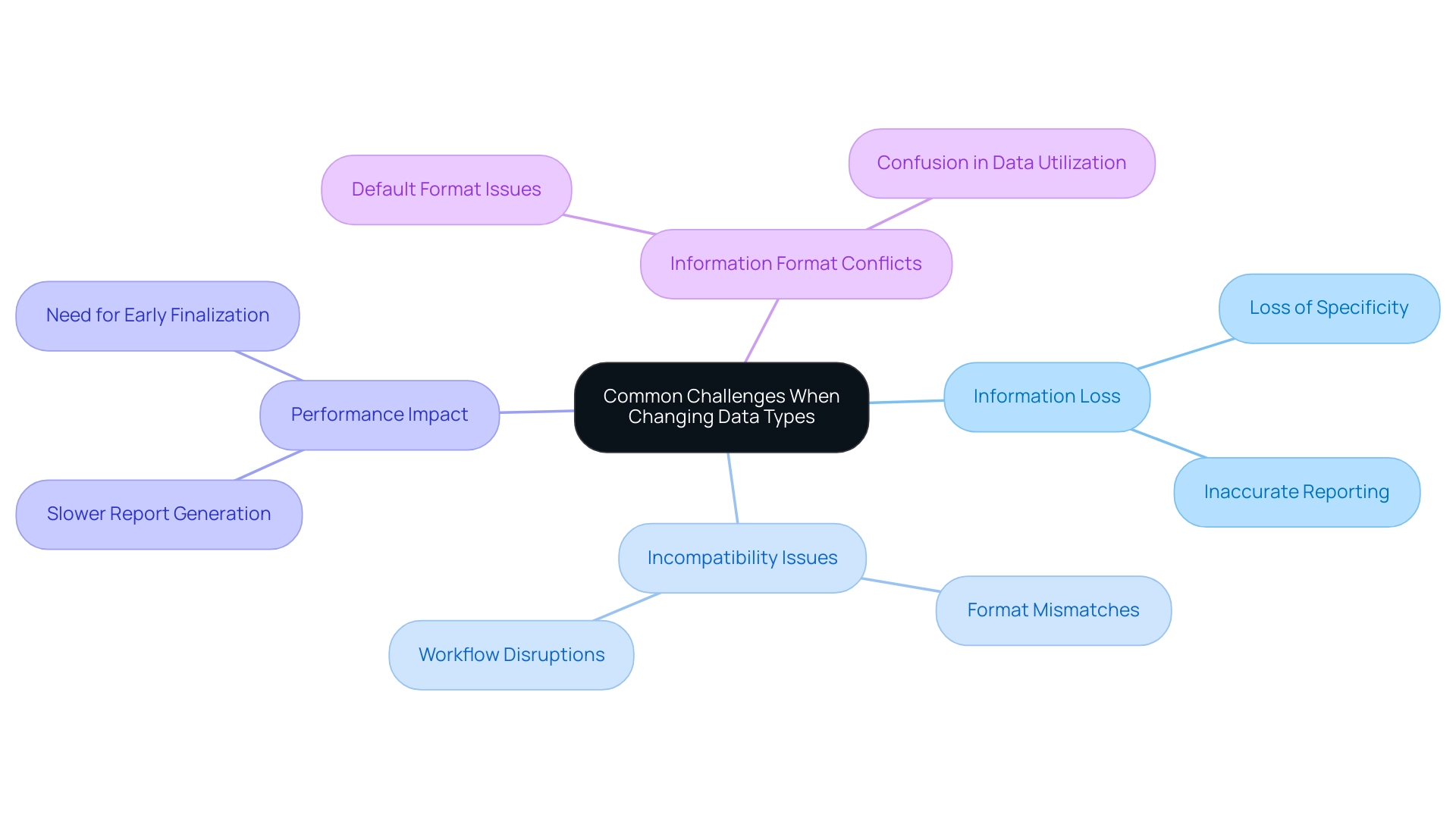
Benefits of Proper Data Type Management
Efficient handling of information categories in BI provides numerous benefits that can greatly improve operational productivity, particularly when integrated with Robotic Process Automation (RPA):
- Enhanced Information Precision: By ensuring that each unit of information is assigned the correct category, calculations and analyses are based on accurate details. This minimizes errors and discrepancies, ultimately leading to more reliable insights. Significantly, the Power BI model accommodates dates ranging from 1900 to 9999, which highlights the necessity of precise classification for temporal information.
- Improved Efficiency: Refining information categories directly contributes to better report performance. Users can anticipate faster load times and more responsive interactions, which are crucial for timely decision-making. When RPA is utilized to automate information input and processing, such as entry from forms and report generation, the efficiency gains are compounded, allowing teams to focus on strategic tasks.
- Improved Information Representation: Precise categories enable visualizations to genuinely reflect the foundational information, promoting deeper analysis and more knowledgeable business choices. With the appropriate information categories, the insights obtained from reports become more actionable, further improved by RPA’s capability to optimize information flows and refresh visual representations automatically.
- Streamlined Information Processing: Properly managed formats simplify the processes of information transformation and maintenance. This not only facilitates easier updates to datasets but also ensures that information remains relevant and usable over time. In the Modeling section, individuals can clearly use PowerBI to change the data type of a chosen column for improved analysis, which is a useful measure that enhances overall information management.
An engaging example of efficient information format management is demonstrated in the case study on Automatic Information Refreshes. The software offers automatic refresh tools for datasets, enabling individuals to view updated insights without manual intervention. This feature, accessible for BI Pro and Premium members, improves information management efficiency and demonstrates the advantages of appropriate information categorization, especially when combined with RPA processes.
As emphasized by analytics enthusiast Douglas Rocha,
Yes, you can, you can do it without measures as well and I will teach you how at the end of this tutorial.
By prioritizing information category management and integrating RPA, users can dramatically enhance their BI experience, driving better business outcomes and maximizing the potential of their information. To learn more about how RPA can transform your information management processes and save time and resources, explore our additional resources.
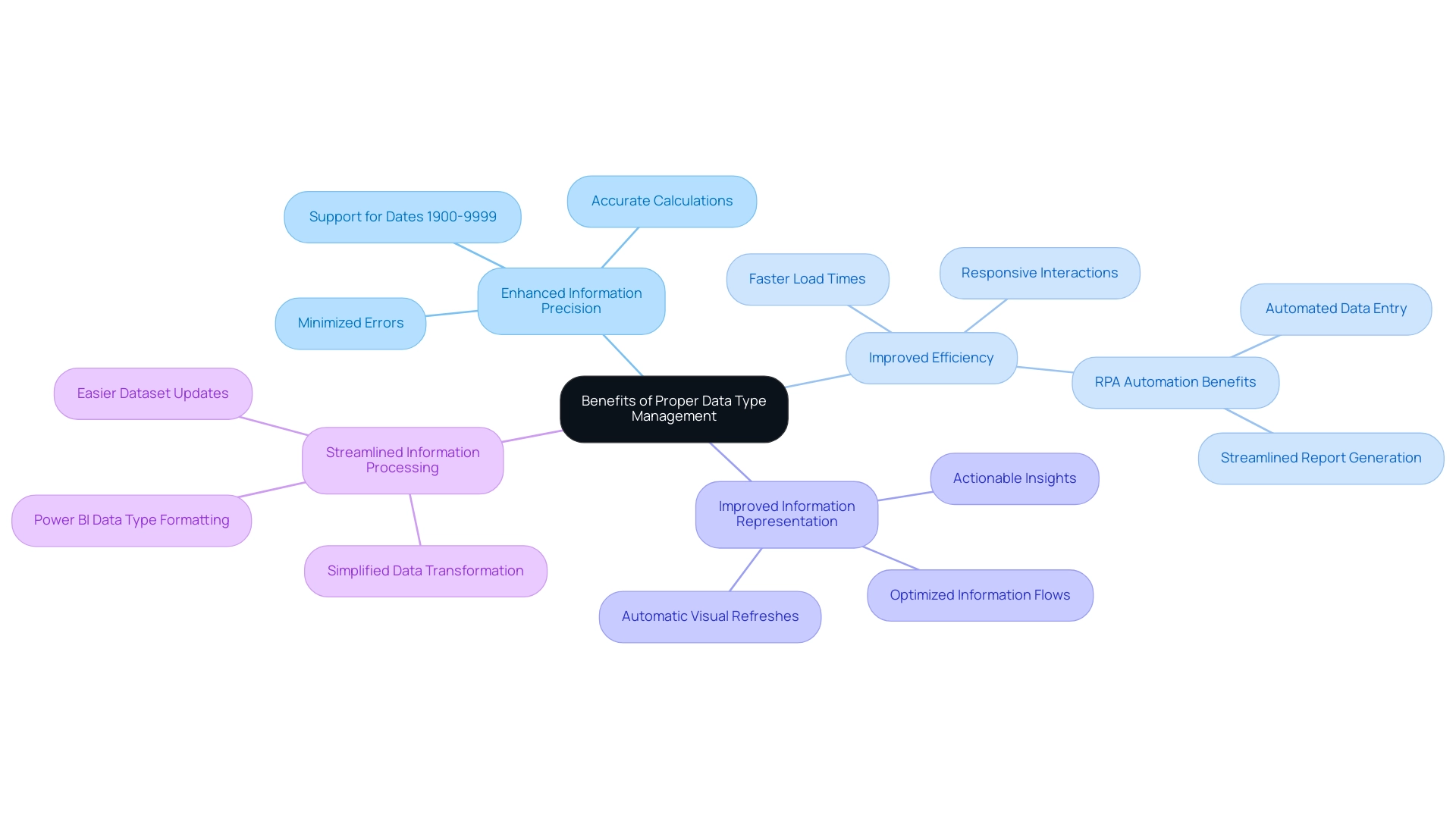
Best Practices for Managing Data Types in Power BI
Effectively handling information categories in BI is essential for improving quality and ensuring precise reporting, directly influencing your operational efficiency and decision-making abilities. Here are essential best practices to consider:
-
Review Information Sources: Regularly evaluate the information categories present in your source files.
This proactive step ensures they align with your analysis requirements before bringing them into BI. With Power BI accommodating dates from 1900 to 9999, comprehending your categories becomes even more essential for effective reporting. -
Establish Consistency: Consistently apply similar information categories across various datasets.
This practice not only mitigates confusion but also decreases the risk of mistakes during analysis, ensuring that your insights are reliable. -
Document Changes: Maintain a comprehensive record of any modifications made to information types, along with the rationale behind these changes.
Such documentation proves invaluable for troubleshooting and maintaining clarity in your information management processes. -
Utilize Information Profiling: Take advantage of Power BI’s information profiling features to gain insights into the distribution and nature of your columns.
This understanding empowers you to make informed decisions and enhances the overall quality of your datasets. -
Train Team Members: Foster a culture of information quality by educating your team on the importance of categories and effective management strategies.
A knowledgeable team can significantly enhance the integrity of your information processes, ultimately resulting in more actionable insights.
By applying these best practices, including the PowerBI change data type feature, you can ensure that your types are meticulously managed, leading to improved analysis and more dependable reporting outcomes. For instance, a global company with over 400,000 employees successfully automated reporting from Salesforce, Webeo, and LinkedIn Ads, reducing manual work from 6 hours per report refresh to daily updates. Additionally, our 3-Day BI Sprint can help streamline this process by creating a fully functional, professionally designed report on a topic of your choice, allowing you to focus on utilizing insights rather than getting bogged down in report creation.
Bill Schmarzo aptly states,
By adopting these best practices for Power BI modeling, you’re not just improving your reports—you’re transforming how your organization makes informed decisions.
Furthermore, consider leveraging custom connectors from companies like Vidi Corp, which specialize in integrating various data sources, further enhancing your data management capabilities and driving efficiency in your business operations. Such transformations are pivotal in today’s data-centric environment.
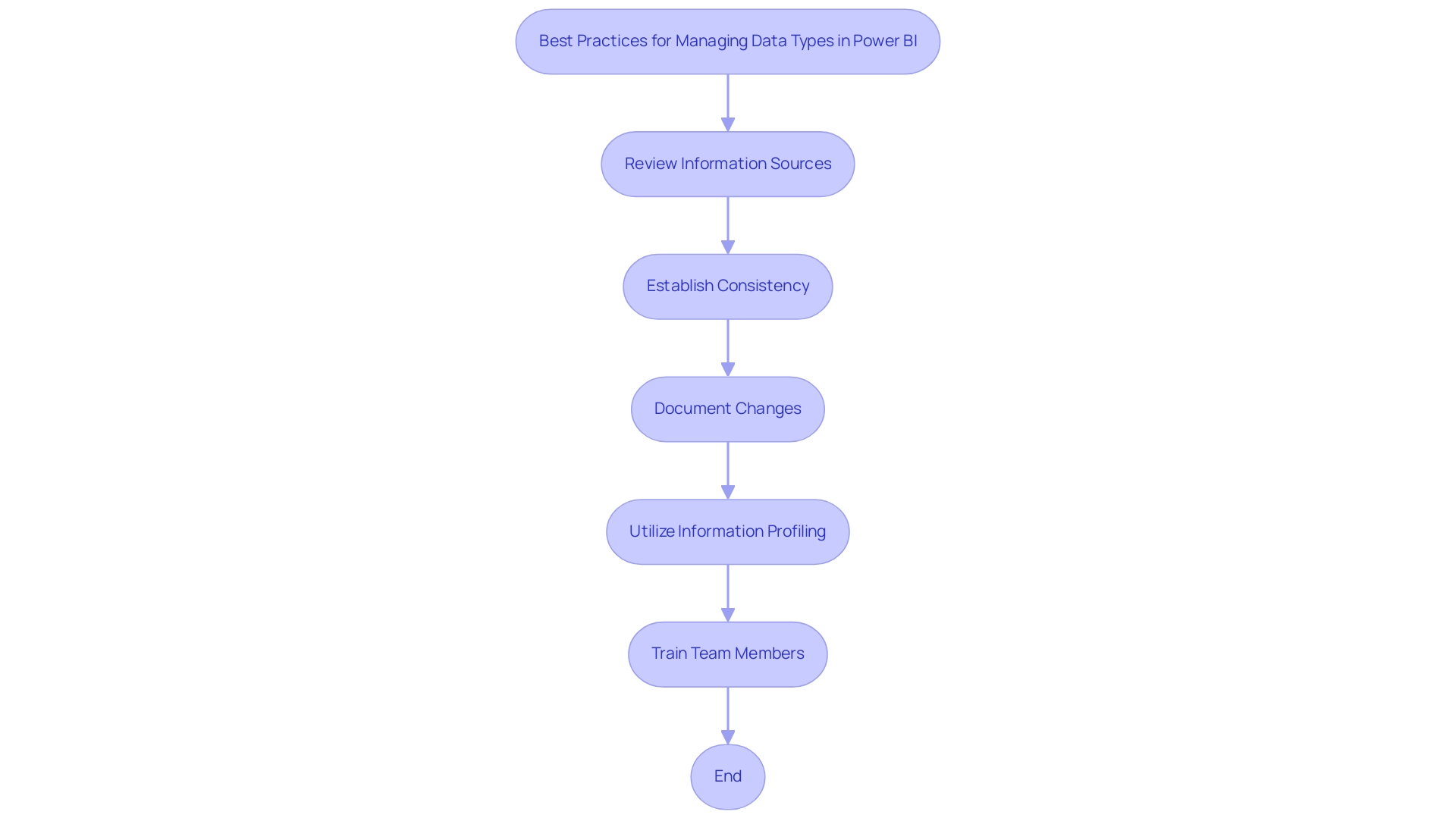
Conclusion
Mastering data types in Power BI is a critical component of effective data management that can significantly enhance organizational performance. By understanding and accurately defining the primary data types—Text, Number, Date, and Boolean—users can ensure precise data interpretation and reporting. The methods for changing data types, whether through the Power Query Editor, Data Model, DAX functions, or RPA solutions, empower users to tailor their data management processes to meet specific analytical needs.
Challenges such as data loss, incompatibility issues, and performance impacts can hinder effective decision-making if not addressed properly. Awareness of these challenges allows users to implement best practices that promote data consistency and accuracy. The benefits of proper data type management are manifold, including improved data accuracy, enhanced performance, and better visualization, all of which contribute to more informed business decisions.
By embracing these strategies and integrating advanced tools like RPA, organizations can transform their data management practices, leading to operational excellence. The proactive approach to data type management not only streamlines processes but also maximizes the potential of data as a powerful asset for growth and innovation. Prioritizing these best practices will pave the way for achieving significant improvements in reporting accuracy and efficiency, ultimately driving better business outcomes.

